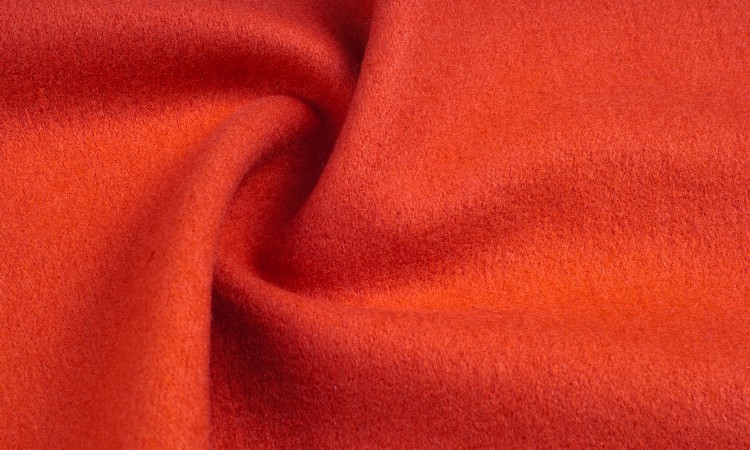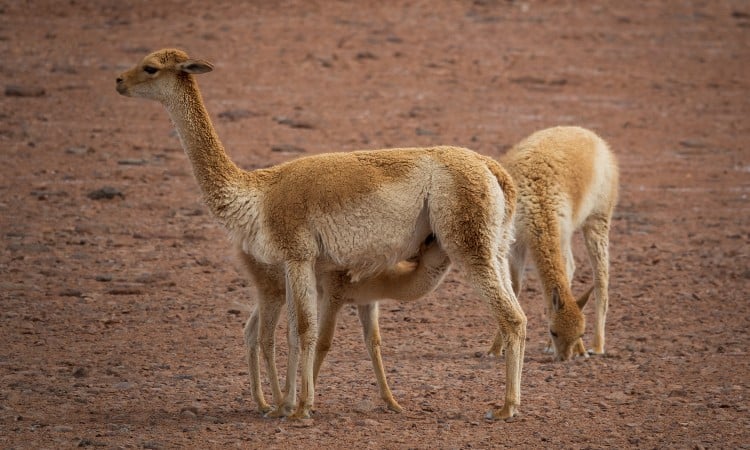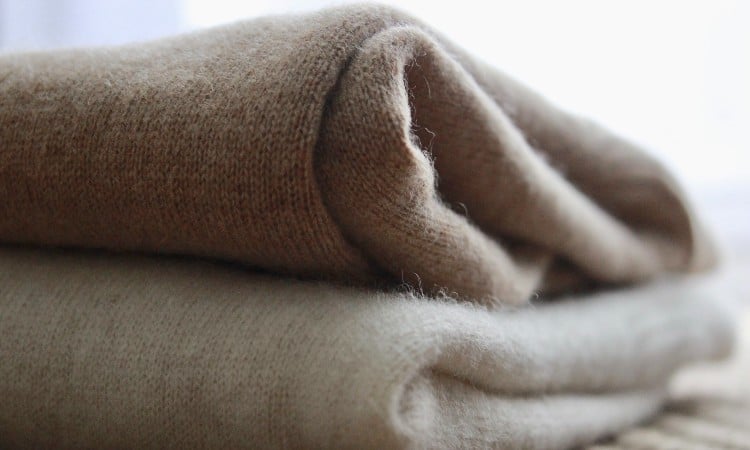There’s nothing cozier on a cold winter’s day than snuggling up in a blanket made from the softest wool in the world. The softer the better, right? So, what is the softest wool in the world?
The softest wool in the world is made from the fleece of the vicuña. A smaller cousin to the llama, the vicuña lives in South America and is the national animal of Peru. Wool from the vicuña is rare, highly desirable, and also the most expensive in the world.
Now you know what the softest wool in the world is, where can you get some and how much will it cost?

Quick Navigation
Is Wool Soft?
The softness of wool depends on the type of wool you’re using and where it came from.
Most of the time when we think of wool, sheep spring to mind. Mainly because sheep were the original go-to source for all things wooly in many parts of the world. These days, as well as having a range of different sheep breeds, wool can come from goats, alpacas, llamas, rabbits, and vicuñas.
The softness of wool comes from the structure of the fleece it was made from. Some sheep have a coarse or heavy fleece that produces scratchy wool. Others, like Merino sheep, have a soft fleece giving beautiful, comfy wool.
This difference in texture is due to the thickness of the wool fiber and its ability to create little curls. Fewer curls per inch of fiber in the fleece means we get scratchy socks from the wool.
Animals known for their fine wool, like alpacas, angora rabbits, and cashmere goats, have an abundance of curls per inch of fiber. Vicuña wool, for instance, has around 100 tiny curls per inch of fiber. Giving us the softest wool on the planet for cozy mittens and warm sweaters.
Softest Wool in the World

Native to South America and the national animal of Peru, the vicuña is the source of the softest wool in the world. The vicuña is a member of the camelid family along with camels, llamas and alpacas. Like many of its relatives, the vicuña has a coat of insulating fur allowing it to withstand the coldest of temperatures. The vicuña commonly live at high altitudes in the Andes, so this fur is essential to their survival.
Unfortunately, the amazing heat-retaining qualities and sheer softness of their fur, is what makes the vicuña both sought after and endangered. It’s also the reason why vicuña wool is one of the most expensive in the world.
Originally a fabric reserved for Incan Royalty, the wool is processed without using chemicals and usually collected by hand. As the animals live in wild herds, they have to be rounded up. On top of that, each animal can only be shorn once every three years.
Overhunting of this adorable animal nearly led to its extinction. At one point back in the 1960s, there were only around 6000 left. Coupled with a low wool yield per year, it’s easy to see why vicuña wool is the rarest in the world too!
Softer and more desirable than cashmere, a pair of vicuña socks are likely to cost you more than $1000. One of the wool’s main disadvantages is the price tag. With an average price of $90 per 500g ball, vicuña is anything but cheap.
The cost is also one of the wool’s advantages, though. Being rare and expensive makes the yarn an exclusive commodity. Attractive to the wealthy as fine coats or sweaters, the popularity and uniqueness of the wool ensure the survival of the vicuña.
Other Types of Soft Wool Fabric

Vicuña may be the softest wool in the world, but there are others available that are easier to come by and less expensive.
Angora
Angora wool refers to the long fur of the Angora rabbit which is spun into soft, plush yarn. The wool is known for its shiny halo that creates a layer of fluff around each hollow fiber. A fluff that gives the yarn its incredible warmth and a silky feel. There are 5 different breeds of angora rabbits, each giving a different color and quality of wool.
Ideal for sweaters, mittens, or other woolen items that don’t need a lot of stretchiness, angora is usually combined with other wools to give it flexibility. Angora wool can cost between $10 – $16 per ounce depending on type and quality.
Alpaca
An all-time favorite, alpaca wool creates a soft and durable fabric that is both water-resistant and unlikely to cause an allergic reaction. Not only is the animal ultra adorable, but the wool is luxuriant and incredibly warm. Used for winter wear, the yarn is popular with knitters and weavers alike. It’s also a great fiber for felting.
Available in a variety of colors and weights for different projects, the wool is versatile and a pleasure to work with. Prices range from $6 – $20 depending on the weight and size of the skein or ball.
Camel Hair
Hair from the Bactrian camel is collected to produce a distinctive tan colored fabric known for high-end coats. The Bactrian is native to the Mongolian region where its coat protects the camel from both intense cold and extreme desert heat. Insulating properties of camel hair are a key factor in its popularity. With a timeless, stylish quality that spans generations, camel hair coats look great on anyone.
Angora and Alpaca wool can be purchased as a yarn, whereas camel hair is usually sold as a ready-made fabric by the yard. Making this wool unsuitable for knitters. Prices can range from $17 – $75 per yard, depending on quality.
Cashmere
The first wool on our list to come from a goat, cashmere is luxurious and unbelievably soft. Known to be one of the softest fibers in the world, it just screams cozy, snuggly sweaters. Cashmere goats are native to the Himalayan mountains where their thick coat protects them from the sub-zero temperatures. Living in such a harsh environment is one of the reasons that cashmere is so expensive.
In order to stay warm themselves, one goat can only supply a small amount of wool per year, usually no more than 200 grams. Processing the fibers reduces this yield even further.
Similar to camel hair, cashmere is normally sold as a fabric or as ready to wear clothing. Prices can range from $40 – $200+ depending on the garment, style, and quality.
Lambswool
Loved by knitters and spinners alike, lambswool, weirdly enough, comes from lambs. The main difference between sheep’s wool and lambswool is its age. Lambs are usually around 7 months old when their first fleece is harvested. The wool is fresh, young, and less coarse than yarn taken from older sheep.
Lambswool is also less likely to cause irritation due to its baby soft qualities. Making it an ideal yarn for warming winter clothes and accessories for tiny humans. Normally sold in balls or skeins, prices can vary but are usually in the region of $7 – $20 depending on quality or brand.
Merino
Merino wool is harvested from one of the world’s oldest breeds of sheep. Native to New Zealand’s south island, the fleece of a Merino sheep can withstand extreme temperature ranges of the Southern Alps.
Thin fibers make this wool soft, cozy and comfortable when worn next to the skin. Merino is an ideal base layer and can be readily found as thermal underwear. Prices range from around $6 to $16 per ball or skein.
Mohair
Angora goats give us mohair. Unlike the fur from their rabbit friends, the hair from the goat has a slightly frizzier look with hairs being visible in garments. The visibility of the hairs can make mohair a little itchy.
Although an angora goat can produce a reasonable amount of wool per year, the end product is not as desirable as other wools on this list. It may be as warm, but the itchy texture is not as soft. The wool is strong and durable though, so can be used for sweaters, scarves, coats, and even suits. One of the cheaper wools, prices can vary from $4 – $10 per ball or skein, depending on quality.
Pashmina
Known for silky shawls and scarves, Pashmina is a finer version of cashmere. So, it’s not really wool in its own right. Softer and with a silkier feel than cashmere, Pashmina has become linked to elegance and style.
Although you can buy wool called Pashmina, it’s actually yarn made up from a mixture of wools including Merino and cashmere, with a bit of silk for added slinkiness. Prices can be anywhere from $30 upwards.
How to Make Wool Softer
There’s no denying that wool is one of the best insulation fabrics. It’s been a staple part of human clothing for generations because it’s just unbeatable for warmth. Unfortunately, the same can’t be said for softness. Not all wools are created equal when it comes to snuggle value.
Some wools can be really irritating. There’s nothing worse than a scratchy sweater or itchy pair of woolen socks. If you have a favorite pair of socks that you just can’t wear because of the intense scratching, all is not lost. You can make the wool softer.
All you need to do is add white vinegar to your rinse water. The vinegar is acidic so will help remove the washing detergent from the wool, so they are less stiff. It also helps smooth out the wool fibers leading to a less scratchy garment.
Conclusion
Wool from the vicuña is warm, soft, and incredibly desirable. Making it a fashion statement for the rich. The desirability and the low levels of wool available each year make it the most expensive, rarest, and softest wool in the world.